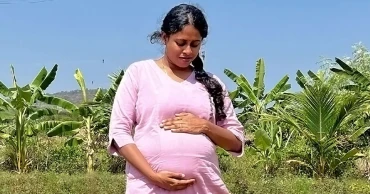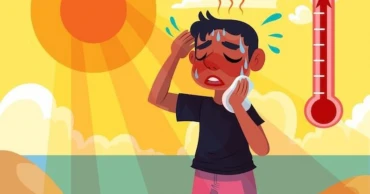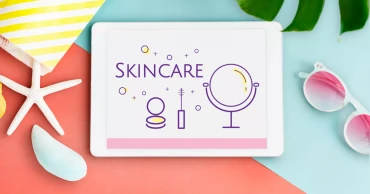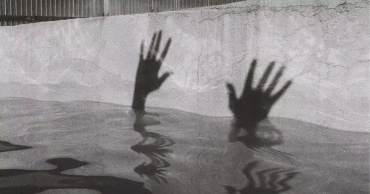Health-&-Fitness
Navigating the Risks of Summer Heat: Essential Health Tips for Pregnant Women
Summer is a time of heat and outdoor activities, but for pregnant women, it also brings the challenge of coping with intense heat waves that can pose serious health risks. From dehydration to heatstroke, the heightened vulnerability of expectant mothers requires careful strategies to ensure their health and that of their developing babies. This comprehensive guide explores practical and effective measures to safeguard pregnant women during these critical months.
Understanding the Risks for Pregnant Women in Summer
Pregnancy demands a lot from the body, which is already managing increased blood volume and the energy requirements of carrying a baby. In the summer, these challenges are compounded by higher temperatures and humidity, which can lead to faster dehydration and overheating. This increased susceptibility makes it essential to adopt preventive measures against heat-related health issues.
Hydration: The First Line of Defense Against Heat
Water is a vital ally for pregnant women during hot weather. Staying well-hydrated is crucial, as dehydration can trigger complications such as overheating, urinary tract infections, and even preterm labor. At least 8-10 glasses of water daily are recommended. Using a reusable water bottle makes it easier to stay hydrated on the go.
Read more: How to Travel Safely During Heat Waves
Electrolyte Management
Alongside hydration, maintaining electrolyte balance is critical. Loss of electrolytes through sweating can be significant in summer. Electrolyte-rich drinks or adding a pinch of salt to water can help restore balance.
Natural sources such as coconut water are also beneficial. It is important to check with a healthcare provider before incorporating new items into the diet, particularly if there are underlying health conditions.
Choosing the Right Clothing
Appropriate attire can significantly influence body temperature. Pregnant women should opt for loose, lightweight, and breathable clothing. Fabrics like cotton and linen are ideal as they allow air circulation and help prevent overheating.
Read more: Summer Tips for School-going Children
Light colors are preferable because they reflect sunlight, whereas dark colors absorb it, increasing heat retention. Comfortable, well-fitting shoes are also essential to accommodate swelling in the feet, a common issue during pregnancy.
Sun Protection Strategies
Sun protection is vital for preventing skin damage and managing body temperature. A wide-brimmed hat, UV-protective sunglasses, and sunscreen with at least SPF 30 are key to guarding against the harmful effects of UV radiation.
Limiting Exposure to Extreme Heat
It is advisable for pregnant women to minimize their time spent outdoors during peak heat hours—typically between 10 am and 4 pm. Planning activities during cooler parts of the day, such as early morning or late evening, can reduce the risk of overheating. When outside, staying in shaded areas or using an umbrella can provide immediate relief from direct sunlight.
Read more: How to Protect Outdoor Workers from Heat Stroke
1 year ago
Summer Tips for School-going Children
As the summer heatwave continues, the risk of heat exhaustion and dehydration becomes a concern. Like adults, children can suffer from severe heat-related illnesses. Therefore, parents and caregivers should be cautious, especially for school-going children who stay outside the home for hours. Here are some essential summer tips to ensure the well-being of school-going children during the hot months.
How to Keep School-going Children Healthy During Summer Heat Waves
Stay Hydrated
Ensuring children stay hydrated is crucial during a heatwave. Parents and caregivers should encourage children to drink plenty of fluids throughout the day, focusing on water as the primary source of hydration. It would be wise to avoid serving children sugary or caffeinated beverages that can contribute to dehydration.
While leaving for school, it is necessary to provide children water bottles and remind them to take regular sips, even if they are not feeling thirsty. Offer water-rich fruits and vegetables like watermelon, cucumber, and oranges as healthy snacks to help keep children hydrated.
Read more: How to Protect Outdoor Workers from Heat Stroke
Dress Appropriately
Lightweight, loose-fitting clothing of breathable fabrics like cotton or linen can help children stay cool. It is highly recommended to opt for light-coloured clothes that reflect sunlight rather than dark colours that absorb heat.
Furthermore, while staying outdoors children can wear wide-brimmed hats and sunglasses to protect their faces and eyes from the sun's harmful rays.
Seek Shade
Children might need to stay outdoors for diverse purposes, like waiting for a school bus. During such situations, children should be encouraged to seek shade or canopies to minimise direct exposure to the sun.
Read more: How to Protect Your Skin and Hair from Sun Damage
Apply Sunscreen Liberally
Sunscreen application is another crucial aspect of sun protection. Like adults, children can use broad-spectrum sunscreen with a high SPF (Sun Protection Factor) of at least 30. Before going to school or other places, kids need to apply sunscreens generously to their exposed skin, including the face, neck, arms, and legs. Nowadays many reputed brands produce child-friendly sunscreen products.
Sunscreen should be reapplied every two hours, or more frequently if children are swimming or sweating heavily. Parents and caregivers should teach children how to apply sunscreen properly and encourage them to build their sun protection routine.
Plan Outdoor Activities Wisely
While planning schedules for active outdoor games and sports during the warmer months, parents should pay attention to the matter that children stay safe from overheating or sunburn. However, when planning outdoor activities, it's essential to schedule them during the cooler parts of the day, such as early morning or late afternoon, to avoid the peak heat hours.
Read more: Summer Drinks: Refreshing Homemade Sherbets to Beat the Heat
Caregivers should guide children to play in shaded areas, such as parks with plenty of trees, or bring portable shade structures like pop-up tents or sun umbrellas to prevent sunburn and heat-related illnesses.
While playing, sweat should be wiped off immediately. Additionally, encouraging regular play breaks in shaded areas allows children to rest and hydrate. It is essential to prevent heat-related illnesses.
Stay Indoors During Peak Heat
During extreme heat, it is best to stay indoors in air-conditioned or well-ventilated spaces for children to avoid heat-related illnesses. It would be thoughtful for the parents and caregivers to plan indoor activities like board games, arts and crafts, or movie marathons to keep children entertained and safe from the heat.
Read more: Beat Dehydration with These Summer Vegetables
Educate About Heat-Related Illnesses
It is essential to teach children about the signs and symptoms of heat-related illnesses, such as heat exhaustion, heatstroke, dizziness, nausea, rapid heartbeat, etc.
Parents and caregivers should teach children to speak up if they are feeling unwell and remind them of the importance of seeking help from a trusted adult if they experience any symptoms of heat-related illness.
Use Cooling Strategies
Implementing cooling strategies like taking cool showers or baths, using fans or air conditioning, and applying cold compresses to the skin can help children beat the heat and stay comfortable indoors.
Read more: Heat Stroke Prevention: Best foods, drinks to avoid heat exhaustion
Parents and caregivers can freeze damp washcloths or water bottles and place them on pulse points like the wrists, neck, and temples to help lower the body temperature of the children. It can make their mind and body cool after returning home from school or outdoors during the heat waves.
Regular Baths
Bathing plays a vital role in maintaining cleanliness. It is important to avoid allowing children to drink or bathe in ice-cold water during hot weather. Instead, offer them water at room temperature or slightly cool.
When bathing, use water at a comfortable temperature, neither too hot nor too cold, to avoid shocking their system.
Read more: Heat Stroke: Symptoms, First Aid, and Prevention
Stay Connected
Staying connected with children, caregivers, and school staff during a heatwave is essential for assuring everyone's safety. Keep lines of communication open with children, caregivers, and school staff during summer.
Sharing information about heat safety tips and encouraging everyone to look out for each other helps create a supportive environment where everyone can stay cool, hydrated, and healthy during hot weather.
Thus, parents and caregivers can minimise the risk of heat-related illnesses in children at home, community space, school, playground, or other places.
Read more: Guidelines issued for primary schools reopening tomorrow amid heatwave
Bottom Lines
Implementing summer safety for school-going children during a heatwave is paramount to their well-being and health. Parents, caregivers, and school staff can help mitigate the risks associated with hot weather, by prioritising hydration, sun protection, appropriate clothing, and staying cool indoors during peak heat hours.
Educating children about heat-related illnesses and empowering them to recognise signs of distress is equally important. By working together and staying aware, the wellbeing and health safety of school children can be assured during the summer months.
Read more: Mist Fan Buyer Guide and Price Ranges in Bangladesh for 2024
1 year ago
Cosmos Group hosts Dhaka Flow at "Health and Safety at Work" Workshop
In order to create a supportive and healthy work environment for all, Cosmos Group has hosted Dhaka Flow, the country’s pioneering yoga and wellness platform, to conduct a workshop for its staff members at Cosmos Center.
The wellness workshop, facilitated by an energetic team of Dhaka Flow, took place from 10 am to 12 pm on Sunday at the Padma Conference Hall, Cosmos Center, Malibagh in the capital.
Yogini, activist and writer Shazia Omar, Chief Executive Officer (CEO) and Founder at Dhaka Flow, and Srabonti Ali, MSW, Licensed Clinical Social Worker (LCSW) and Mental Health Counselor, Lighthouse Therapy BD, conducted two enlightening and energizing sessions at the workshop, enthusiastically participated by the Cosmos Group staff. Dhaka Flow Co-Founder and Chief Marketing Officer (CMO) Tahsin N Choudhury, was also present at the workshop.
Masud Jamil Khan, Deputy Managing Director of Cosmos Group, and Honorary Consul of Ireland in Bangladesh; Nahar Khan, Executive Director at the Cosmos Foundation and Gallery Cosmos, Executive Editor at United News of Bangladesh (UNB) and Vice President of the Cosmos Group; Shawkat Hossain, Vice President at Cosmos Group; Farid Hossain, Editor of UNB; and other officials and staff members of Cosmos Group joined the two-hour workshop.
After the Introductory Icebreaking session, Shazia Omar facilitated ‘Tips to Stay Healthy at Work’ and shared her valuable insights regarding well-being in the workplace. She conducted a wellness assessment of the participating staff and shared some powerful health hacks while orchestrating activities such as calming breath and visualisation, short yoga-based exercises during busy days such as stretching and emphasized the importance of proper nutrition and sleep.
1 year ago
How to Protect Outdoor Workers from Heat Stroke
The scorching heat waves can pose serious health risks, especially for people who stay outdoors for long hours due to occupation. During hot weather situations in summer, people working under the sun may suffer from heat-related illnesses like dehydration, heatstroke, etc. Let’s explore some effective tips to safeguard outdoor workers from the debilitating effects of heat waves.
What is Heatstroke?
Heat stroke is a severe heat-related illness characterised by a body temperature of 104°F (40°C) or higher. It arises when your body overheats and the body's internal temperature regulation system fails, typically due to prolonged exposure to high temperatures or strenuous physical activity and dehydration. It is most prevalent during the summer season.
Immediate medical attention is necessary for heatstroke. If left untreated, it can swiftly lead to damage to vital organs such as the brain, heart, kidneys, and muscles. Delaying treatment exacerbates the damage, heightening the risk of severe complications or even death.
Read more: Summer Heatwave: Here’s How to Keep Children Safe
Symptoms of Heat Stroke
The most common symptoms of heatstroke include:
- High body temperature (above 104°F or 40°C)- Altered mental state, such as confusion or disorientation- Nausea and vomiting- Flushed or red skin- Rapid breathing- Rapid heartbeat.
Read more: Heat Stroke Prevention: Best foods, drinks to avoid heat exhaustion
1 year ago
How to Protect Your Skin and Hair from Sun Damage
To maintain the health of skin and hair, it is essential to take regular care in every season. The heat waves during summer months cause sweating and dehydration. Understanding how to protect and nourish the skin and hair can help you to minimise damages caused by sun heat. This article will explore effective tips to keep your skin and hair healthy, glowing, and protected during the warmer months.
Skincare Tips for Summer
.
Hydration is Key
Drinking plenty of water throughout the day is important to stay hydrated from within. Proper hydration helps maintain skin elasticity and suppleness, preventing it from becoming dry and flaky under the summer sun. It also keeps you safe from heat stroke caused by the scorching summer heat.
Cleansing and Exfoliating
You should cleanse your skin twice daily to remove sweat, dirt, and sunscreen buildup. It is also necessary to exfoliate regularly to unclog pores and remove dead skin cells. It can promote a smoother and more radiant complexion.
Read more: Collagen Supplements: Benefits, Side Effects, Dosage
Lightweight and Non-Comedogenic Products
It is highly recommended to opt for lightweight, oil-free moisturisers, serums, and sunscreens that won't clog pores or feel heavy on your skin. Try to look for products labelled "non-comedogenic" to prevent breakouts.
Introduce Antioxidants
It would be beneficial to incorporate antioxidant-rich skincare products into your routine to combat free radical damage caused by UV radiation and environmental pollutants. You should look for ingredients like vitamin C, vitamin E, and green tea extract.
Sun Protection
It is crucial to apply sunscreen with a high SPF (Sun Protection Factor) to all exposed areas of your skin, including your face, neck, arms, and legs. Reapplying sunscreen every two hours is equally important, especially if you are swimming or sweating.
Read more: How to Choose the Right Sunscreen for Your Skin
Customised Skincare
Not every person has same type skin. Customising skincare routine acording to the specific type and condition of skin can help to avoid rashes and other skin related issues.
It is vital to tailor your skincare routine to suit your skin type. If you have oily skin use oil-free water-based products, hydrating products for dry skin, and use gentle, non-irritating products for sensitive skin.
Use Sun Protection Clothes and Acessories
Experts suggest to wear lightweight and breathable clothing during extreme hot weather. It would be wise to choose light-cloured and cotton fabric made clothes to stay safe from heat exhaustion.
Besides choosing summer-freindly outfits, you need to use protective acessories like umbrellas, hats, and sunglasses for added protection.
Read more: Korean Skincare Routine: 10 Skincare Hacks
Healthy Eating
It is very important to eat a balanced diet rich in fruits, vegetables, and omega-3 fatty acids to nourish your skin from the inside out. You should limit your sugary and processed foods intake, which can contribute to inflammation and breakouts.
1 year ago
Circadian Rhythm: How to Reset the Biological Master Clock
Have you ever wondered why human beings tend to sleep at night and work during the day? With exceptions aside, that’s how almost everyone functions. Lack of sleep makes us cranky throughout the day. Why does that happen? It's all related to our biological master clock or circadian rhythm.
What is Circadian Rhythm?
The circadian cycle refers to the metabolic changes that occur within a living organism over 24 hours. The term ‘Circadian’ comes from two Latin words Circa meaning around and Diem meaning day.
Circadian rhythm is a natural, internal process that regulates the sleep-wake cycle and repeats roughly every 24 hours. This rhythm is influenced by external cues such as light and temperature along with internal factors including genetics and hormones.
Read more: What is Autism spectrum disorder? Why is Autism Awareness Important?
How Does Circadian Rhythm Work?
Just like a master clock regulates the time zone across the world, there’s also a master clock in the human body that regulates sleep patterns and sense of time. It's situated in the hypothalamus of the brain, specifically in an area called the suprachiasmatic nucleus (SCN).
The SCN receives input from the eyes, particularly light-sensitive cells in the retina, which helps synchronize the internal clock with the external day-night cycle.
The circadian rhythm regulates the sleep-wake cycle by controlling the time alertness of the human body through melatonin production. Additionally, it also plays a significant role in body temperature regulation.
Circadian rhythm disorder is generally caused due to genetic factors, erratic light exposure, medical conditions, age-related changes, psychological stress, etc.
Read more: Cerebral Haemorrhage: Signs, Reasons, Treatment, and Prevention
Symptoms of Circadian Rhythm Disorder
There are several symptoms of circadian rhythm disorder. The common ones include:
Insomnia
The most common symptom of circadian rhythm disorder is difficulty with sleep or insomnia. A patient gradually develops difficulty in either falling asleep or staying asleep. Waking up multiple times at night is also attributed to this disorder.
Increased Daytime Sleep
A decrease in sleep quality results in increased daytime sleepiness. This symptom is directly related to sleep difficulty as waking up multiple times during the night results in drowsiness throughout the day.
Early Wakeup
At a more advanced stage, a person might find it difficult to fall asleep after waking up during the night. Sleep deprivation triggers fatigue which inherently harms other body processes.
Read more: Why are Suicide Rates Higher Among Men?
Concentration Difficulty
People with circadian rhythm disorder may find it difficult to concentrate or face memory-related problems. The lack of balanced sleep affects certain cognitive functions of the brain and affects decision-making capabilities.
Mood Swings
Circadian rhythm disorder may trigger severe mood swings. It increases the risk of depression and anxiety leading to BPD at later stages.
Besides, physical symptoms like headaches and gastrointestinal issues may be caused by the disorder.
Read more: Self-care Tips for Parents of Newborns
Types of Circadian Rhythm Disorder
The difference in sleep-wake cycle characteristics resulted in several types of circadian rhythm disorders. The prominent ones are:
Delayed Sleep Phase Disorder
Delayed Sleep Phase Disorder of DSPD is the most common type of this disorder. A person with DSPD has a convoluted biological clock which makes it difficult for them to sleep at conventional bedtimes. As the name suggests, DSPD delays the conventional sleeping time by several hours. The subsequent result is sleepiness continued well into the day.
Advanced Sleep Phase Disorder
ASPD is the opposite of DSPD. In this case, an individual might experience a sleep cycle well in advance compared to the conventional sleeping times.
Irregular Sleep-Wake Rhythm Disorder
Irregular sleep-wake rhythm disorder is usually triggered by insomnia or fragmented sleeping patterns. Waking up multiple times during a sleep cycle may induce an irregular disorder.
Read more: 7 Types of Strength Training And Their Benefits
Shift Work Sleep Disorder
Shift work sleep disorder is seen among people with unconventional work hours. For example, a person working night shifts may find it difficult to sleep during the day. The result is sleepiness and drowsiness in the subsequent work shifts at night.
Non-24-Hour Sleep-Wake Disorder
Non-24-hour sleep-wake Disorder is usually noticed among individuals with complete blindness. The lack of light perception makes the brain lose perception of the light-dark cycle in 24 hours. As a result, affected individuals experience a gradual shift in their sleep-wake schedule, leading to periods of insomnia and excessive daytime sleepiness.
Jet Lag Disorder
Jet lag disorder is seen among individuals who travel between several time zones. Unlike the other types, jet lag disorder usually improves once the body gets adjusted to the new timezone. However initial symptoms may include sleeplessness, digestive issues, and reduced cognitive functions.
Read more: Colon Cancer: Everything You Need to Know
How to Reset the Circadian Rhythm
Circadian rhythm can be restored through certain lifestyle changes. In addition, behavioral strategies, and sometimes medical interventions may be needed to improve the condition. Here are some strategies to get started.
Practicing a Consistent Sleep Schedule
One of the best ways to reset the circadian rhythm is to maintain a strong routine. It is recommended to go to bed and wake up at a fixed time every day, even on weekends. This would allow your body to get used to a consistent cycle and adjust accordingly.
Light Exposure
Circadian rhythm is greatly regulated by light and dark. Try and increase your light exposure when you wake up in the morning. Go for a short walk or spend some time on the balcony. The more you’re exposed to natural light in the morning, the more the body adjusts to the wake period.
Read more: How Does Physical Activity and Exercise Affect Testosterone Levels?
Limit Night Time Exposure
Just as the opposite of morning, limit the light exposure at night. It is advised to avoid the use of blue light emitting sources like TV and mobile late at night. This will help in the production of melatonin which will naturally induce sleep.
Create a Relaxing Environment
Avoid stressful work during the night if possible. Create a relaxing environment by listening to slow music, reading a book, taking a shower, or practicing meditation to ease brain functions.
Avoid Day Naps
It can be helpful to avoid naps during the day. If you can’t entirely avoid them, try and limit naps to no more than 30 minutes. Long naps during the day will interfere with nighttime sleep.
Read more: Measles: Causes, Symptoms and Prevention
Avoid Stimulating Substances
It is recommended to avoid stimulating substances like coffee, tea, or nicotine before sleep. It might trigger hyperactivity in the brain which will deter the usual sleeping time.
Consult a Healthcare Professional
If the disorder persists, consult a healthcare professional. A trained medical practitioner can provide personalized treatment for the disorder.
Final Words
The circadian rhythm or biological clock ensures a healthy sleep-wake cycle in the human body. When this rhythm goes off balance it may result in several complications in physical and emotional health. Fortunately, it is possible to reset the circadian rhythm without medical intervention unless in extreme cases. Make sure to lead a routined and disciplined lifestyle including a timely sleep schedule to maintain a healthy rhythm.
Read more: How Does Fat Leave the Body When We Lose Weight?
1 year ago
What is Autism spectrum disorder? Why is Autism Awareness Important?
Autism spectrum disorder (ASD) is a complex developmental condition that affects individuals in various ways. Understanding autism and raising awareness about it is crucial to creating a more inclusive and supportive society.
World Autism Awareness Day, observed on April 2, serves as a reminder of understanding and supporting individuals with autism. Let's delve deeper into the intricacies of autism and why awareness about it is important.
What is Autism?
Autism, also known as autism spectrum disorder (ASD) or autism spectrum condition (ASC), is a neurodevelopmental variation in brain functioning, influencing communication, interaction, and learning patterns. People with autism may have difficulty understanding social cues, expressing themselves verbally or nonverbally, and engaging in repetitive behaviours or interests.
Autism is a spectrum disorder, meaning that it affects each individual differently, ranging from mild to severe. It is crucial to understand that autism is not a sickness; it is a lifelong condition present from birth. Various therapies are available to assist individuals in coping with challenges and leading fulfilling lives.
Read more: Cerebral Haemorrhage: Signs, Reasons, Treatment, and Prevention
Signs of Autism
Signs of autism can vary widely among individuals, but common signs include challenges in social interaction, communication difficulties, and repetitive behaviours. Specific signs may include:
- Avoidance of eye contact - Lack of interest in pointed-out objects- Delayed language development compared to peers- Diminished engagement with others- Preference for objects over people- Difficulty participating in interactive games- Heightened or reduced sensitivity to sensory stimuli- Resistance to changes in routine- Repetitive and restricted use of toys- Echoing of words or phrases- Repetitive movements.
Read more: Why are Suicide Rates Higher Among Men?
Causes of Autism
The rising rate of autism suggests a complex interplay of factors, with genetics playing a significant role. Scientists have identified rare gene mutations and common genetic variations linked to autism. Emerging research focuses on the interaction between genetic predisposition and environmental influences.
For instance, maternal exposure to harmful substances during pregnancy could contribute to genetic mutations associated with autism. The disorder's multifaceted nature highlights the need for further investigation.
1 year ago
Cerebral Haemorrhage: Signs, Reasons, Treatment, and Prevention
Cerebral haemorrhage is often referred to as intracerebral haemorrhage (ICH) or hemorrhagic stroke. It is a critical medical condition characterised by bleeding within the brain tissue. This condition requires immediate medical attention. This article delves into some basic knowledge about ICH to ensure proper diagnosis and treatment.
What is Cerebral Haemorrhage?
Cerebral haemorrhage or ICH, is a type of stroke that occurs when a blood vessel in the brain bursts and bleeds into the surrounding brain tissue. This bleeding disrupts the blood supply to the brain and damages brain cells.
According to research, cerebral haemorrhage is the second most common cause of stroke. Research also shows that ICH is the deadliest type of stroke, with a mortality rate of around 40%-50% within the first month.
Read more: Why are Suicide Rates Higher Among Men?
Types of Cerebral Haemorrhage
.
Intraparenchymal Haemorrhage
Intraparenchymal haemorrhage (IPH) is a type of bleeding that occurs within the brain tissue. According to Wikipedia, IPH is the most common type and accounts for around 8-13% of all strokes and can arise from various underlying conditions. IPH may lead to death or significant disability This is why it is an urgent medical situation requiring immediate attention.
Intraventricular Haemorrhage
Intraventricular haemorrhage (IVH) is caused by bleeding in the ventricles, which are fluid-filled cavities in the brain. These produce and circulate cerebrospinal fluid, a protective cushion for the brain and spinal cord. It can arise from physical trauma or as a result of a hemorrhagic stroke.
According to Wikipedia, around 30% of IVH cases are primary, while 70% are secondary. It has been observed that IVH occurs in approximately 35% of moderate to severe traumatic brain injuries. Consequently, IVH typically accompanies extensive associated damage, leading to unfavourable outcomes in most cases.
Read more: Reasons Why Ramadan Fasting is More Beneficial Than Dieting
What Causes Cerebral Haemorrhage
.
Head Trauma
Head injuries from accidents or falls can damage blood vessels in the brain. It may lead to brain haemorrhage in individuals under the age of 50.
High Blood Pressure
Untreated hypertension can weaken blood vessel walls. It increases the likelihood of a brain haemorrhage.
Aneurysm
Abnormal bulges in blood vessel walls are known as aneurysms, which occur when blood vessel walls weaken and swell. It potentially leads to a burst and subsequent brain bleeding and can result in a stroke.
Read more: Daily Strategies for Neuroplasticity: Enhancing Focus and Alleviating Anxiety
Blood Vessel Abnormalities
Arteriovenous malformations (AVMs) cause weakness in blood vessels in and around the brain, often only detected when symptoms arise.
Amyloid Angiopathy
This blood irregularity is typically seen in older adults with high blood pressure. It can lead to small unnoticed bleeds that may eventually result in a larger brain haemorrhage.
Blood Disorders
Conditions like haemophilia and sickle cell anaemia contribute to lower blood platelet levels and clotting. These increase the risk of brain bleeds.
Blood Thinner
While essential for some conditions, blood thinners can increase the risk of bleeding, including cerebral haemorrhage.
Read more: Good Stress: What Are the Benefits of Eustress?
Liver Disease
People with liver conditions have an elevated risk of bleeding issues, including brain haemorrhage.
Brain Tumours
Individuals with a history of brain tumours are at a heightened risk of developing cerebral haemorrhage.
Symptoms and Signs of ICH
Key symptoms of cerebral haemorrhage may include:
- Sudden and severe headache- Nausea and vomiting- Weakness or paralysis on one side of the body- Difficulty speaking or understanding speech- Vision problems- Loss of consciousness- Seizures- Dizziness- Loss of coordination- Difficulty balancing- Abnormal sense of taste- Difficulty swallowing- Difficulty writing or reading- Loss of fine motor skills.
Read more: Which Vitamins are Essential for Women?
How to Diagnose and Treat ICH
To diagnose a brain bleed, a healthcare provider conducts an immediate physical and neurological examination, alongside reviewing the patient's medical history and symptoms. Following this, they may order imaging tests such as a CT scan, MRI, or MRA to assess the location, extent, and potential cause of the bleeding.
Additional tests, including an electroencephalogram, chest X-ray, urinalysis, complete blood count (CBC), eye exam, lumbar puncture (spinal tap), or angiography, may also be utilised to detect underlying causes.
The treatment for a brain bleed varies depending on the severity and location of the bleed. Healthcare providers strive to halt the bleeding and tackle the root cause. Treatment options may encompass surgery and medication.
Prompt medical intervention can minimise brain damage, enhancing the prospects of recovery. Additionally, patients may receive supplemental oxygen through a ventilator, nutrients and fluids intravenously or via a feeding tube, and close monitoring in an intensive care unit to ensure stable vital signs.
Read more: How to Improve Focus by Training the ‘Attention Muscle’
1 year ago
Why are Suicide Rates Higher Among Men?
Suicide is a tragic and complex phenomenon that affects individuals and communities worldwide. Mental health negligence, particularly concerning men, has become a pressing concern. Despite increasing awareness of mental health issues, men often face unique challenges that make them more vulnerable to suicide. This article delves into the various factors contributing to this troubling trend.
Global and Local Statistics of Suicide: Male vs Female
Females, especially those under 25, exhibit higher rates of non-fatal suicidal behaviour and suicidal ideation, and attempt suicide more frequently. But, in reality, males have a significantly higher rate of completing suicide than females. This phenomenon is commonly known as the gender paradox in suicide.
Around the world, more men than women die by suicide. According to Wikipedia, in 2008 and 2015, the number of male suicides was about 1.8 to 1.7 times higher than female suicides globally. In Western countries, men are three to four times more likely to die by suicide compared to women. In 2015, around two-thirds of global suicide deaths (representing about 1.5% of total deaths) were among men.
Data from The National Violent Death Reporting System (NVDRS) in the USA for 2016 revealed that for every female suicide, there were about 3.5 male suicides. However, in China, the rates of suicide between men and women were almost the same. The male vs female suicide ratio is 9.1:10.3.
Read more: Good Stress: What Are the Benefits of Eustress?
In 2019, the rate of suicide deaths among males was over 3.5 times higher than that among females. By 2021, this disproportionate rate increased to over 3.9 times higher.
According to the CDC, in the USA, men experienced a suicide rate four times higher than that of women in 2021-2022.
In Bangladesh, the scenario is quite the same – more men than women commit suicide here. In 2017, there were over 11,000 recorded suicides. The average age for male suicide victims was about 28.86 years, while for females, it was about 25.31 years old.
In 2019, 3.70 people took their own lives out of every 100,000 people in Bangladesh. The male suicide rate was 5.70 while the number is 1.70 for females. Also, the police records indicate a rising trend in suicides over the years. At the same time, psychologists estimate that around 11,000 people end their lives annually in Bangladesh.
Read more: Students with Depression: Tips for Parents and Educators
1 year ago
Reasons Why Ramadan Fasting is More Beneficial Than Dieting
In pursuing a healthier lifestyle, the choice between Ramadan fasting and traditional dieting holds significance. Both practices impact health and eating habits, but which one emerges as the more beneficial option? Let's embark on a journey exploring the nuances of these two approaches and their impact on well-being.
Benefits of Month-long Fasting during Ramadan
.
Holistic Detoxification
Ramadan fasting goes beyond the typical notion of dieting for weight loss. It involves a unique detoxification process where the body undergoes a thorough internal cleansing. The fasting period allows organs to rest and rejuvenate which promotes optimal functioning and contributes to overall health.
Mindful Eating and Discipline
Unlike conventional dieting, which solely focuses on restricting calories, Ramadan fasting instils a sense of discipline and mindfulness in eating habits. The structured nature of fasting encourages individuals to be more aware of what and how much they consume. Thus, Ramadan fosters a healthier relationship with food in the long run.
Read more: Healthy Sehri Meal Recipes for Ramadan Fasting
Spiritual and Emotional Well-being
Ramadan fasting is more than just a physical practice; it is deeply rooted in spirituality. The act of fasting is not only an exercise for the body but also for the mind and soul. This spiritual dimension contributes to emotional well-being and enhances a sense of inner peace, gratitude, and resilience.
Community Support and Bonding
One of the distinctive aspects of Ramadan fasting is its communal nature. Individuals come together to fast and create a supportive environment beyond personal discipline. This sense of community support and bonding provides emotional strength and motivation, elements often lacking in individualistic dieting journeys.
Sustainable Lifestyle Changes
Month-long fasting during the holy Ramadan encourages a holistic approach to health that extends beyond the month of fasting. The discipline and mindful eating habits cultivated during Ramadan can translate into sustainable lifestyle changes. This helps individuals maintain a balanced and health-conscious approach to nutrition throughout the year.
Read more: Ramadan Fasting with Diabetes: Best foods for Sehri and Iftar
Balanced Nutritional Intake
While dieting may sometimes lead to nutrient imbalances or deficiencies, Ramadan fasting emphasises a balanced nutritional intake. The pre-dawn and post-sunset meals, suhoor and iftar, are carefully planned to include a variety of food groups which ensures that the body receives essential nutrients.
Improved Digestion
The intermittent fasting pattern during Ramadan allows the digestive system to rest and function more efficiently. This can lead to improved digestion, absorption of nutrients, and a reduction in digestive issues, contributing to better health.
Controls Blood Sugar
During Ramadan fasting, insulin sensitivity can improve, lowering the risk of type 2 diabetes. When cells become unresponsive to insulin, insulin resistance can develop – a precursor to diabetes. Fasting prompts the body to use stored glucose for energy, reduces glucose levels, and enhances insulin sensitivity.
Read more: Healthy Iftar Meal Recipes for Breaking Ramadan Fasting
Promotes Weight Loss
Fasting aids weight loss by regulating portion sizes and cutting calorie intake. However, it is crucial to avoid overeating after fasting periods to maintain progress. Sustaining healthy eating habits and exercise during non-fasting hours is vital for lasting weight loss. Ramadan fasting offers a chance to reset eating patterns and foster healthier food relationships.
Good for Cardiac Health
Ramadan fasting positively affects heart health by decreasing blood pressure and cholesterol, reducing inflammation, and enhancing blood circulation. This minimises the risk of heart disease and stroke. Those with existing heart conditions should seek medical advice before fasting, ensuring it aligns with their health needs.
Improves Brain Function
Ramadan fasting boosts cognitive performance and brain function notably by elevating the production of brain-derived neurotrophic factor. This protein fosters brain cell growth and survival, heightening memory, learning, and mental clarity.
Read more: Ramadan Fasting Benefits: Impacts on health when you fast for 16 hours
Increases Growth Hormone Secretion
During Ramadan fasting, the body's growth hormone secretion is naturally enhanced. Research indicates that fasting increases human growth hormone (HGH) levels. This hormonal surge supports metabolism, aids weight loss, and promotes muscle growth, contributing to health benefits during the fasting period.
Could Extend Longevity
Examining periodic fasting's impact on the human gut, a study observed an increased diversity of beneficial gut bacteria, notably Christensenella species linked to longevity. Additionally, researchers identified heightened sirtuin levels, proteins crucial for metabolic regulation and longevity. Further research is essential to grasp fasting's longevity effects and identify optimal fasting protocols.
Reducing Cancer Risk
The American Cancer Society Journal suggests intermittent fasting could aid cancer treatment and prevention by reducing tumour growth and chemotherapy toxicity in certain cases. However, they stress the necessity for more robust clinical trials and advise cancer patients to undertake intermittent fasting within clinical settings. Further research is imperative to comprehensively understand fasting's impact on cancer.
Read more: 10 Healthy Iftar Drinks for Breaking Ramadan Fasting
1 year ago



















